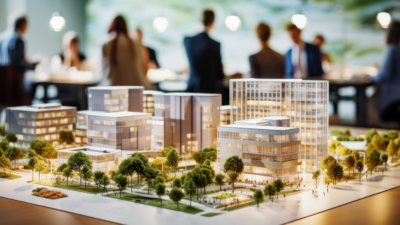Healthcare conversions have proven successful for many years, but today’s unique market conditions have prompted more practices to consider repurposing existing sites, specifically converting vacant office buildings for medical functions.
The U.S. office vacancy rate continues to rise, climbing to 15% in Q1. This excess of empty offices provides a unique opportunity for practices looking to take the next steps in ownership or expansion.
Compounding the ample supply of offices, the cost to build from scratch is prohibitive for many practices. Along with ongoing economic challenges, companies are seeing already high construction estimates go up 10% to 20% over original calculations.
The Benefits of Converting
One of the primary advantages of converting a building is the cost efficiency. New construction is expensive and finding reasonably priced land to build on is scarce. Construction rates – and timelines – continue to go up due to inflation, supply chain holdups and labor shortages.
Choosing to go the acquisition and conversion route can enable physicians to build significant equity as physician practices are facing economic headwinds, and can provide an additional revenue stream. Overall, converting an existing structure can cost $100/sq. ft. less to rehab than a new building, allowing owners to create value while lowering operational costs. Additionally, bypassing the need to build from scratch, owners can increase speed to market.
The location of these assets, often centralized within hubs of office, retail and multi-family, is another key benefit and can improve visibility and a practice’s care delivery. These favorable locations allow systems and practices to execute their strategy to be out in the community by providing convenience for patients where they work, shop and live.
These kinds of multi-tenant assets can additionally open up the opportunity to co-locate with other physician groups to provide a synergistic medical center as a “one stop shop” for patients.
Infrastructure Considerations
If a practice chooses to move forward with a conversion, there are key elements to evaluate when selecting the right fit.
Since convenience is often an important factor for patients choosing a provider, parking is an important consideration. Is there enough parking, or room for expansion? According to research from NAIOP, a helpful gauge is looking for sites that have, at a minimum “a ratio of four to five spaces per 1,000 square feet of office space.”
Inside the structure, building systems including HVAC, floor and electrical loads need to be adequate for medical use or in good enough condition to be updated at a reasonable cost.
The physical layout also needs to be considered. Does the column spacing enable an efficient medical clinic design? Can it support a modern plan to handle post-pandemic waiting rooms, telemedicine, and move patients comfortably through corridors and between pods? If the practices will be doing surgical procedures, it is important to ensure proper covered drop-in/drop-off areas, and that elevators meet requirements for capacity and gurneys.
Given all these considerations, it is crucial to have a team of real estate experts guiding this process, providing due diligence for vetting the right types of properties that would make suitable candidates for conversion to first class medical standards.
What We Are Seeing
Our Colliers Healthcare experts have helped several healthcare practices with site selection, advisory services, financing and negotiation for office conversions. In one recent case in suburban Atlanta, the practices turned a vacant, three-story office building into a Class A medical office that we subsequently sold for a five-fold return on investment.
Under current market conditions we expect to see this activity grow in Sunbelt states, large suburban areas where practices may want multiple locations with equity opportunities and any market where there is competing demand in multiple sectors for land.
While traditional office is currently stagnant, medical office is stable and thriving, and there is greater opportunity right now for physician groups to take advantage of this kind of conversion.

 Michael Lipton
Michael Lipton

 Shawn Janus
Shawn Janus
